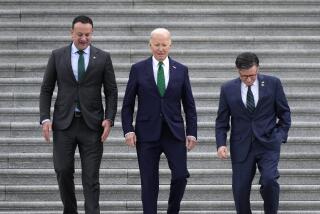Money Supply Expands $1.9 Billion
- Share via
NEW YORK — The nation’s basic money supply expanded $1.9 billion in late March, the Federal Reserve said Thursday.
The increase in the basic supply, called M1, generally met credit analysts’ expectations, as did increases in two broader measures of money that the Fed also reported.
As a result, the monetary data had little impact on the bond market, which already had scored a major rally before the late-afternoon release of the central bank’s figures.
There remain suggestions that, since the money supply has been growing at a faster clip than is targeted by the Fed, the central bank might soon be inclined to tighten credit, if only slightly, so as to curb any inflation threat.
However, David Jones, an economist for the government securities firm Aubrey G. Lanston & Co., argued that the Fed “now is placing much more weight on the economy” as opposed to money growth.
“Instead of the Fed being faced with the choice of keeping a stable monetary policy or tightening, the choice is now between a stable stance or in fact easing of policy by midyear,” Jones said. “That means short-term interest rates could be coming down.”
The Fed said M1 rose to a seasonally adjusted $574.7 billion in the week ended April 1 from $572.8 billion in the previous week.
M1 represents funds readily available for spending and includes cash in circulation, checking deposits and non-bank travelers checks.
A broader measure of money, called M2--which includes M1 plus certain types of savings--rose $7.3 billion in March to $2.4274 trillion from $2.4201 trillion.
A third measure, called M3--which adds M2 to certain investments, such as large bank certificates of deposit--expanded $12.5 billion in March to $3.053 trillion from $3.0405 trillion.
The Fed reports M2 and M3 monthly.
Analysts said Federal Reserve Chairman Paul A. Volcker hinted earlier this week that the Fed might not tighten credit anytime soon when he expressed concern about the economy’s ability to keep growing.
Volcker said softness in manufacturing, mining and agriculture--areas especially hard hit by the strong dollar--could threaten the economy’s overall expansion.
This and other developments within the last few weeks “suggest that the Fed may be willing to provide an enlarged volume of reserves to the banking system,” Henry Kaufman, chief economist of Salomon Bros., wrote in his weekly credit commentary.
“In particular, the weakness in the latest retail-sales data suggests that consumer demand, a key force behind the economic expansion, is waning somewhat,” he said.
For the latest 13 weeks, M1 averaged $568 billion, a 10.5% seasonally adjusted annual rate of gain from the previous 13 weeks.
The Fed has said it would like to see M1 grow between 4% and 7% from the fourth quarter of 1984 through the fourth quarter of 1985, a slightly narrower growth range than the 4% to 8% of the previous year.
Other indicators released included:
- Commercial and industrial loans at major New York City banks rose $144 million in the week ended April 3, compared to a decline of $410 million a week earlier.
- Commercial paper outstanding rose $516 million in the week ended April 3, compared to a $1.21-billion increase in the previous week.
- Member bank borrowings from the Federal Reserve System averaged $575 million in the week ended Wednesday, up from $386 million in the previous week.
- Total adjusted reserves of member banks averaged a seasonally adjusted $40.327 billion in the two weeks ended Wednesday.
More to Read
Inside the business of entertainment
The Wide Shot brings you news, analysis and insights on everything from streaming wars to production — and what it all means for the future.
You may occasionally receive promotional content from the Los Angeles Times.










